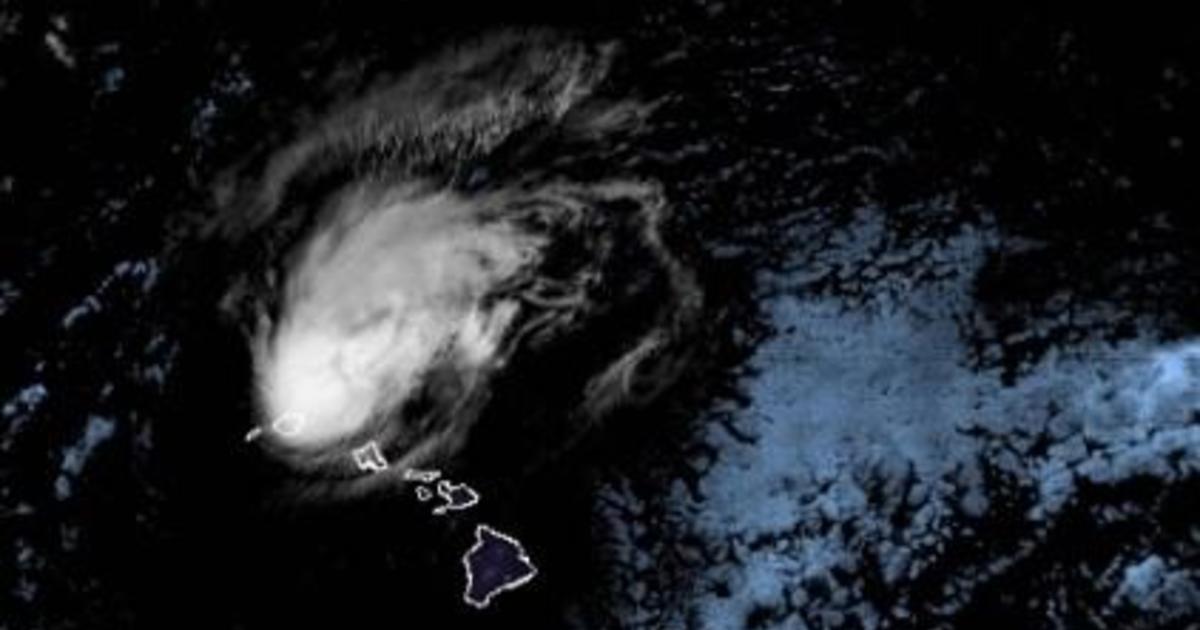Honolulu — Hurricane Douglas gained some strength and began to spin away from many of the Hawaiian Islands as it skirted the state late Sunday.
Forecasters said a hurricane warning was canceled for Oahu but remained in effect for Kauai County, including the islands of Kauai and Niihau, which could still be hit by the system with strong wind gusts and rough surf.
“It’s still not out of the realm of possibilities. So we want people to really remain vigilant and stay prepared, at least for tonight,” Eric Lau, a meteorologist with the National Weather Service in Honolulu said Sunday.
As of 11 p.m. Sunday Hawaii Standard Time (5 a.m. Eastern Daylight Time), Douglas was 100 miles northwest of Honolulu. It had maximum sustained winds of 90 mph, making it a Category 1 hurricane.
Hurricane Douglas was skirting Hawaii very late on July 26, 2020.
Central Pacific Hurricane Center
Heavy rain and wind gusts battered Maui during the morning Sunday, downing a small tree on the Hana Highway.
Gentle rain fell and blustery winds swayed trees on Oahu, home to the state’s biggest city, Honolulu. Sand and debris washed ashore on a two-lane coastal road.
Despite the dangers, surfers rode waves and residents took selfies at a lookout point next to the ocean.
Lau said Douglas would have been a lot worse had its track been 20 or 30 miles to the south.
One reason is that this path put Douglas to the north of the state and not directly over the islands. Another is that this path mostly put the island chain near the southwest quadrant of the storm, which is often less destructive than the northeast and the right side of a hurricane’s eye, Lau said.
A police officer uses a plywood board to push beach debris off the road in Kaaawa, Hawaii, on July 26, 2020, ahead of Hurricane Douglas, which was causing ocean swells in certain areas around Oahu with water washing up on some roads.
MARCO GARCIA / REUTERS
“We were really playing with a really fine line, a razor thin line between what we’ve experienced today compared to what we could have experienced,” he said.
Duke Stevens, who lives in Hana on Maui’s eastern tip, said by early afternoon there was no longer any wind and the light rain that fell persistently through the night had subsided. “I’ve seen a lot worse,” said Stevens, who’s lived on Maui since 1987.
Antonia Hall, of Kihei, in west Maui, said the storm avoided her area, although she and others were prepared for the worst. “Maui has skirted so many hurricanes,” she said. “This is just kind of something we go through here.”
About 300 people evacuated to the Hawaii Convention Center on the edge of Waikiki. On Maui, 22 people were at five shelters around the island.
Evacuees were told to bring masks and hand sanitizer along with the usual emergency supplies of food and water. People will have to wear face coverings to be admitted, and will have to wear them unless they are eating, drinking or sleeping.
A surfer hits the waves in Hauula, Hawaii, on July 26, 2020, before the expected arrival of Hurricane Douglas.
MARCO GARCIA / REUTERS
State health department officials contacted each of the 625 people who were currently in isolation or quarantine as of Friday because they are either COVID-19 positive or have been in contact with someone who is. Every one of those indicated they would shelter-in-place and not seek refuge at a hurricane shelter.
Hawaii has some of the lowest coronavirus infection rates in the nation, but COVID-19 numbers have been rising in recent weeks. For three consecutive days through Saturday, Hawaii reported record highs of newly confirmed cases.
President Trump issued an emergency declaration for Hawaii because of the hurricane, directing federal assistance to supplement state and local response efforts.
Hawaiian Airlines canceled all Sunday flights between Hawaii and the U.S. mainland and also between the islands.
Rainfall was expected to be between 3 to 6 inches, with locally higher amounts possible.
